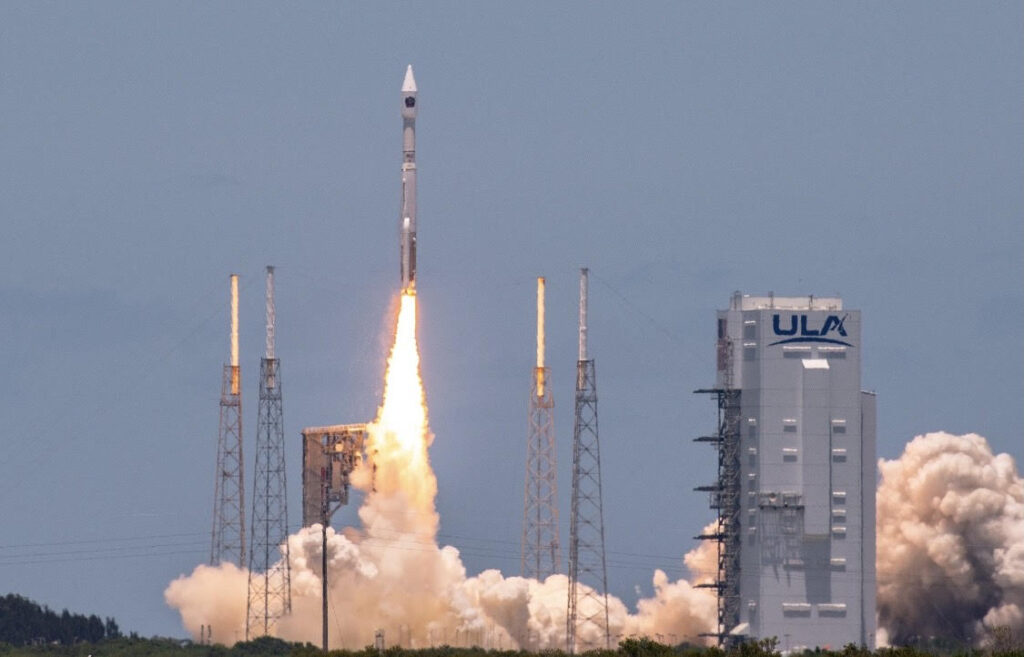
The Space Force had a rough go with House appropriators. (DoD)
WASHINGTON: The House Appropriations Committee (HAC) slammed the Air Force and Space Force for failing to make any discernible progress toward reforming space acquisition in its 2022 budget report.
“The Committee remains concerned that the Air Force has not taken more aggressive action in addressing longstanding space acquisition issues and has made little progress in defining what the Space Force will be doing that is fundamentally different than when it was a component of the Air Force,” the report, released ahead of a Tuesday full committee markup, said.
Overall, House appropriators avoided major damage to the Space Force’s budget request. The lawmakers trimmed a mere $25 million from the overall procurement request of $2.77 billion, while cutting $492 million from the research, development, test and evaluation (RTD&E) request of $11.26 billion. (Intriguingly, one of the biggest individual line-item cuts in RTD&E was to “classified programs” — with HAC chopping $410.5 million from Space Force’s request of $4.475 billion.)
That said, the HAC is clearly unhappy with space acquisition management and lawmakers are largely unconvinced that proposed changes in the Space Force’s organizational structure will resolve long-standing problems.
The HAC report notes that the Office of Cost Assessment and Program Evaluation (CAPE) has concluded that the planned launch in 2025 of the first Next Generation Overhead Persistent Infrared (Next-Gen OPIR) missile warning program satellite, being built by Lockheed Martin, is “unrealistic” and that the program’s overall cost estimate is “overly optimistic.”
“The Committee cautions the Space Force that providing unrealistic cost and schedule estimates undermines the credibility of the Space Force’s management of this and other programs,” the report warned.
While the HAC fully funded the $2.54 billion request for Next-Gen OPIR, the lawmakers demanded a thorough program scrub and required Space Force to report back in 180 days after the defense appropriations bill is passed.
The report dedicates an entire page to detailing the committee’s dissatisfaction with what it sees as foot-dragging on space acquisition reform — which was one of the primary congressional rationales for the creation of the new space service in the first place. Indeed, the HAC reiterates: “The Committee believes the Space Force was established to bring greater attention and focus to fixing its acquisition issues because previous attempts to do so did not produce lasting results.”
The HAC’s concerns include that that Department of the Air Force — which oversees the Space Force much as the Navy oversees the Marine Corps — still has no clear plan for creating a separate management chain for space acquisition. Similar concerns were voiced at a May hearing by both the chair and ranking members of the HAC defense subcommittee, Rep. Betty McCollum, D-Minn., and Rep. Ken Calvert, R-Calif., respectively.
The 2020 NDAA required that the Air Force appoint a Senate-confirmed assistant secretary for space acquisition and integration. That person, the act said, “will “synchronize with the Air Force Service Acquisition Executive on all space system efforts, and take on Service Acquisition Executive responsibilities for space systems and programs effective on October 1, 2022.”
While Acting Air Force Secretary John Roth told the HAC-D in May that he, too, believed the space acquisition executive should be named “as soon as possible,” that has yet to happen — with a nominee unlikely to be named until after the Senate confirms the Biden administration’s nominee for Air Force secretary, Frank Kendall. Kendall is currently facing a hold on his nomination placed by Sens. Elizabeth Warren, D-Mass., Gary Peters, D-Mich., and Mike Lee, R-Utah, flowing from past decision-making.
The House appropriators also scold the Space Force for, in essence, simply re-arranging the deck chairs on space systems buying practices in the planned transformation of the Los Angeles-based Space and Missile Systems Center (SMC) to a new Space Systems Command.
The HAC report thunders:
The fiscal year 2022 budget request is the first budget developed by the Space Force since its establishment, yet jt includes many of the same type of “big juicy targets” that the current Vice Chairman of the Joint Chiefs of Staff has warned against for at least four years. The Space Force lacks a clear plan which defines its future space architecture and lacks a strategy for how this architecture will be acquired.
The plans for establishing the new acquisition unit, Space Systems Command, consist primarily of renaming the Space and Missile Systems Center and incorporating existing space launch units. The plan does not resolve the fundamental issues of overlap and duplication in roles, responsibilities, and authorities among the various other space acquisition units in the Department of the Air Force.
Perhaps more worrying, the House appropriators say, is that Space Force lacks a coherent, evidenced-based plan for the future space architecture — i.e. the overarching configuration of the various US military space systems fielded for various missions, from communications to missile warning to positioning, navigation and timing.
“The Committee believes the Space Force needs a clear and concrete vision for its future system architectures, based not on philosophy but on rigorous technical analysis with executable plans resourced by realistic budgets,” the report says.
To that end, the HAC report recommends that SMC’s basic organization be “re-examined” and “encourages” the Air Force to “consider organizing units around mission-based program areas whlch correspond to their operational counterparts in Space Operations Command.” In addition, the report suggests a move “to simplify the decision chain from program managers to program executive officers to a service acquisition executive.”
Space Operations Command, or SpOC, is one of three Space Force commands announced last June, along with SSC and Space Training and Readiness Command (STAR Command). It oversees operations of US military satellites, and is headed by Lt. Gen. Stephen Whiting.
The House appropriators also refused to fund Space Force’s planned new Space Warfighting Analysis Center (SWAC), aimed at conducting analysis, modeling, wargaming, and experimentation to create operational concepts for space war, finding that it duplicates the current Space Security and Defense Program (SSDP). SSDP was created in 2013 by the deputy defense secretary and the deputy director of national intelligence to bring together military space planners with those of the Intelligence Community, in order to undertake similar activities aimed at ensuring the resiliency of national security space systems.
Instead, the HAC added $10 million to the budget request for SSDP of $56.5 million; and zeroed the $37 million request for the SWAC.
Multi-ship amphib buy could net $900M in savings, say Navy, Marine Corps officials
Lawmakers gave the Navy authorities to ink a multi-ship amphib deal years ago, but the service has not utilized that power yet.


























